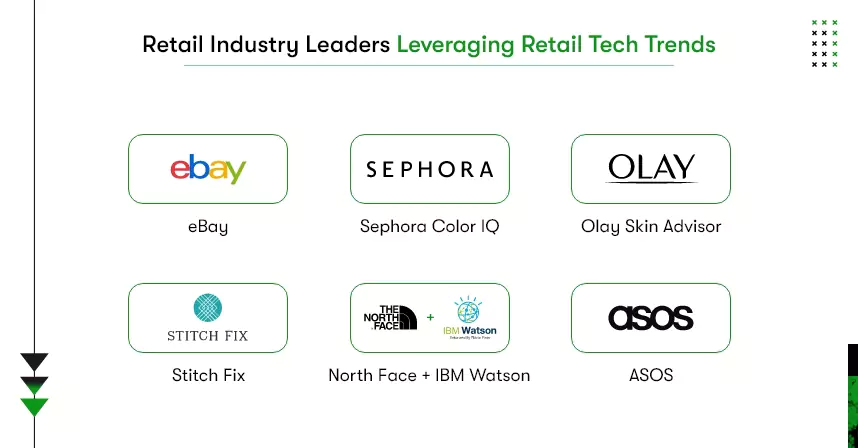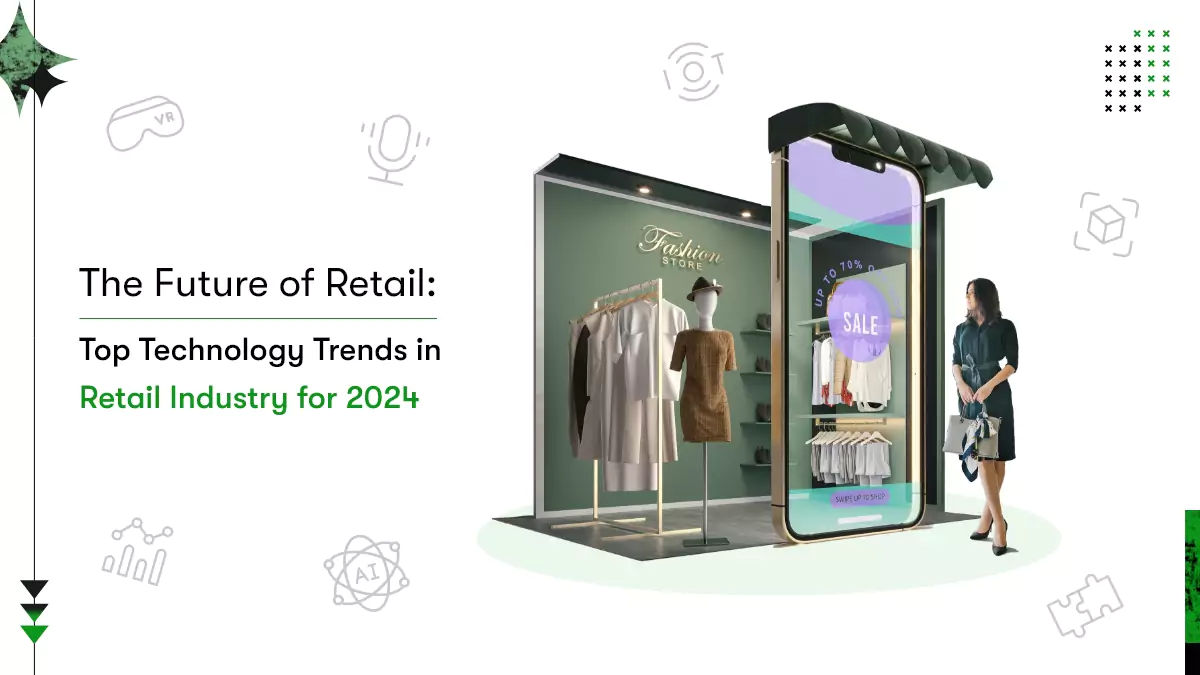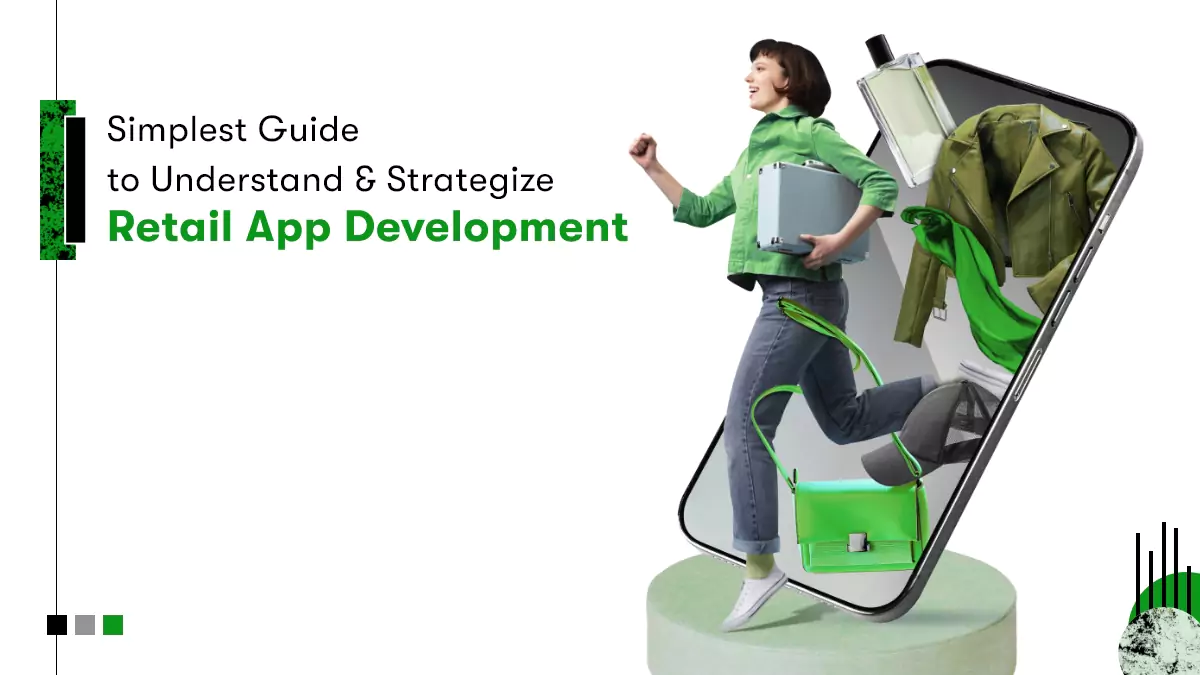Once, customers browsed aisles and made purchases. Now, they step into an immersive world where artificial intelligence tailors suggestions based on their preferences. Every innovation, from AI-driven customer insights to seamless omnichannel experiences, is a step toward a future that blurs the lines between the physical and digital realms.
That makes digital transformation in retail a do-or-die for businesses. Because emerging technologies in retail are insane. For example, by analyzing their previous behavior, you can predict what your customers want and serve their interests right on their smartphones.
But what happens when you overlook these technology trends in the retail industry?
We’re talking about an expedition where each step in digital adoption could mean a leap toward business triumph. So, will you join the revolution or watch from the sidelines?
That’s your call, but keeping you informed about these retail tech trends is ours. So, let’s deep dive into the dynamic world of retail technology, answering the most common question…
What if you ignore the Retail Technology Trends of 2024?
While retail technology evolves at breakneck speed, standing still means getting shadowed by competitors. The retail landscape of 2024 demands agility, foresight, and a willingness to digitize. Ignoring the latest retail technology trends might seem like a cost-saving, but it could lead to significant missed opportunities, risks, and business loss.
Retailers using AR are seeing a 94% higher conversion rate. Not using AR means missing out on these engagement and conversion benefits.
Over 70% of chatbot conversations will be AI-driven by 2023. By not adopting, you overlook a key tool for enhancing customer satisfaction.
More than two-thirds of retailers agree that digital transformation is crucial for increasing revenue and customer relationships.
With an increasing number of consumers shopping on mobile devices, failing to optimize for mobile could result in losing sales and customer engagement.
Without leveraging data analytics, you could miss insights on consumer behavior, market trends, and operational efficiencies.
But if you embrace the future of retail technology, you can get to,
- Enhance your Online Presence: Embracing digital trends can dramatically boost your online visibility and customer reach.
- Make Data-Driven Decisions: Harnessing technology for data analytics can lead you to more informed, strategic business decisions.
- Lead Customer Experience Innovation: Technology allows for creative, personalized shopping experiences, resulting in improving customer loyalty and satisfaction.
- Increase Operational Efficiency: Integrating modern technologies can streamline supply chain operations, reducing costs and increasing efficiency.
Since you are now aware of the consequences of using and not using technologies, let’s explore futuristic retail technology trends!
Ground-shaking Technology Trends in Retail that Retailers Should Choose to Accept

Advanced AI and Deep Learning
From front-end customer interactions to back-end operations, AI and its deep learning method drive a revolution in the retail industry. Making large dataset analysis a piece of cake, Artificial Intelligence and deep learning help you understand the industry’s dynamics. Here’s how you can make AI in retail work miracles for your business and yield potential results.
| AI & Deep Learning Use Cases | Potential Results |
| Personalized Product Recommendations | Increase sales and customer satisfaction through tailored shopping experiences. |
| Predictive Inventory Management | Reduce overstock and stockouts and improve efficiency in the supply chain. |
| Customer Behavior Analysis | Provide a better understanding of customer preferences, leading to more effective marketing strategies. |
| Dynamic Pricing Strategies | Optimize pricing based on market demand and consumer behavior, potentially increasing profitability. |
| Chatbots for Customer Service | Enhanced customer support with reduced operational costs, available 24/7. |
| Fraud Detection and Prevention | Reduce losses due to fraud and increase transaction security. |
Generative AI
The talk of the town ChatGPT and its success is why the Generative AI trend is sprouting in every industry. Luckily, retail is no exception. This cutting-edge tech trend in retail includes using AI algorithms in your retail business to generate new content, forecast demand, etc.
Basically, Generative AI opens up possibilities for retailers to offer personalized and dynamic customer experiences. Here’s a snapshot of how you can leverage Generative AI in your retail business.
| Generative AI Applications in Retail | Functions and Uses |
| Customer Service | Employ NLP and NLG to understand and respond to customer needs effectively. |
| Creative Assistance | Help in conversational commerce, product catalog management, new product development, and automating customer service tasks. |
| Product Descriptions | Quickly generate detailed product descriptions, guides, white papers, and marketing materials like blogs, emails, and campaign content. |
| Chatbot Responses | Enhance chatbots with the ability to create natural, relevant responses to customer inquiries. |
| Targeted Ad Content | Create personalized and effective ad content tailored to specific customer segments. |
Augmented and Virtual Reality
Shoppers seek a deeper connection with products before purchasing. By making them more confident in their choices and desires, you can not only offer engaging shopping experiences but also strengthen this connection. And this is where Augmented and Virtual Reality come into play. Besides entertaining customer expectations, using AR/VR strategically can also put you ahead of your competitors in the market.
| AR & VR Use Cases in Retail | Potential Results |
| Virtual Try-Ons (Clothes, Accessories, Makeup) | Increase customer confidence in purchases and reduce return rates. |
| Product Demonstrations in AR/VR | Accelerate product understanding and lead to informed purchasing decisions. |
| Interactive AR Marketing Campaigns | Boost customer engagement with your brand, leading to viral marketing campaigns. |
| Virtual Showrooms | Allow your customers to explore products in a 3D space, enhancing their decision-making process. |
Hyper-Personalization Through Advanced Data Analytics
Data analytics is a threshold to understand the nuances of your customer needs and preferences. Harnessing these customer insights, you can offer hyper-personalized experiences across multiple channels, including your website, apps, social media, and more. Furthermore, you can leverage the data to send precise product recommendations over SMS, push notifications, email, etc.
| Hyper-Personalization Use Cases | Potential Results |
| Customer Segmentation | Enables targeted marketing, improves customer engagement, and increases sales efficiency. |
| Customized Marketing Campaigns | Boost marketing effectiveness and increase ROI on marketing spend. |
| Predictive Customer Behavior Modeling | Anticipate customer needs and allow for proactive business strategies. |
| Send targeted promotions based on purchase history at their preferred time | Increase customer engagement and the likelihood of purchases by notifying. |
| Inventory Optimization Based on Predictive Analytics | Reduce overstock and stockouts and optimize supply chain efficiency. |
The Integration of Robotics Process Automation in Retail
Integrating RPA in retail means freedom from repetitive tasks, including inventory checks, processing customer queries, and more. By automating your operations, RPA allows you to free up your team to focus on growing your businesses. Here’s the list of RPA use cases in retail companies that you must consider.
| RPA in Retail Use Cases | Potential Results |
| Inventory Management | Automate stock tracking, reducing errors and saving time, resulting in precise inventory management and reducing stock discrepancies. |
| Customer Service and Support | Automate answering of routine customer inquiries, providing quick and accurate responses. Thereby improving customer satisfaction and freeing up human resources for complex tasks. |
| Order Processing and Fulfillment | Automate order entry, tracking, and fulfillment processes. |
| Data Entry and Management | Automate routine data entry tasks, ensuring accuracy and improving data quality to gain reliable insights for decision-making. |
| Supply Chain Operations | Automating communications and logistics planning, driving smoother operations, timely deliveries, and cost savings. |
| Financial Processing | Automate invoice processing and financial transactions, accelerating processing time and errors. |
Voice Shopping
71% of consumers prefer conducting voice searches to manually typing their queries.
On the other hand, around 60% of online shoppers reported to Statista about purchasing daily or weekly through their smart home voice assistants, including Amazon Echo, Google Home, etc.
By integrating voice-enabled devices and shopping services, you can offer an intuitive and effortless customer experience aligning with the modern lifestyle of the new generations. Here’s a brief breakdown of how this trend can impact various aspects of retail:
| Voice Interaction Use Cases | Potential Results |
| Product Searches and Inquiries | Make browsing products and shopping effortless, increasing customer convenience and satisfaction. |
| Voice-activated ordering | Streamline the purchasing process, potentially increasing sales and repeat business. |
| Customer Support and FAQs | Provide efficient, hands-free customer service, enhancing the overall customer experience. |
| Personalized Shopping Assistance | Offer tailored product recommendations based on voice interactions, improving personalization. |
| Feedback and Reviews via Voice | Encourage customer engagement and collect valuable feedback for service improvement. |
Next-Generation IoT and Smart Retail Environments
Channeling the power of IoT-enabled devices and sensors, you can create a highly connected smart shopping environment. Since IoT devices communicate with each other, sending data in real-time, you can recommend precise products by analyzing customers’ behavior at once. Besides product recommendations, you can leverage IoT in numerous other ways, for example,
| IoT Use Cases in Digital Retail | Potential Results |
| Virtual Shopping Assistants | Harnessing collected data through IoT devices, you can offer personal shopping assistants that offer product recommendations and customer support based on user behavior and preferences. |
| Predictive Product Placement | IoT data lets you predict products more likely to trend and optimize online store displays and inventory accordingly. |
| Smart Logistics and Delivery | IoT-enabled logistics systems can indicate the optimal routes and delivery methods, reducing shipping times and costs. |
| IoT-Enabled Customer Feedback Loops | Speed up customer response time using IoT sensors to gauge customer reactions to products through real-time feedback systems. |
| Smart Inventory for Demand Sensing | Build IoT systems that dynamically monitor market trends and social signals to adjust inventory levels, avoiding overstocking and stockouts. |
| Automated Quality Control | IoT sensors can help monitor product quality throughout the supply chain, ensuring high standards and reducing returns. |

Mobile Technologies
7.1 billion confirmed mobile device users were there in 2021. Now, think, if you are not using mobile technology in your retail business, how many potential customers are you losing?! When it comes to using mobile technology, you have many opportunities. For example, developing an e-commerce app, mobile payment app, and mobile POS system or leveraging it to offer push notifications.
| Mobile Technology Applications | Potential Results |
| Mobile Commerce Applications | Enhance shopping convenience, increase sales, and improve customer loyalty. |
| Mobile Payment Integration | Simplifies the checkout process, reducing cart abandonment and increasing conversion rates. |
| Push Notifications and Alerts | Keep your brand at the top of customers’ minds, promoting sales and new products effectively. |
| Augmented Reality in Shopping Apps | By introducing AR in your shopping app, you can offer immersive shopping experiences anytime, anywhere. |
You may ask, what is the best way to leverage mobile technologies? Well, if you are planning to build a shopping app or mobile payment app, you must give Flutter a thought!
Flutter app development enables you to create apps from a single codebase for multiple platforms–Android, iOS, and Web. Meaning you won’t have to create separate apps for each platform. Consequently, Flutter app developers save you costs and time by about 40%.
How Industry Leaders Leverage Retail Tech Trends
Think about today’s retail giants. Are they merely following trends, or are they defining the future of shopping? How are retail companies using AI, AR, and GenAI to revolutionize the shopping experience?
The technology trends in retail we’ve discussed aren’t just concepts for tomorrow; they’re realities, and retail titans are making billions through these innovative techs. So, let’s explore how retailers are setting the stage for a new era in retail.

- eBay: eBay uses AI for various functions, including customer advice, personalized recommendations, and enhancing shipping and delivery times.
- Sephora Color IQ: Sephora’s AI-powered product, Color IQ, scans shoppers’ skin to provide customized shade recommendations for foundation and concealer, enhancing in-store personalization.
- Olay Skin Advisor: Olay offers a tool that analyzes shoppers’ selfies to diagnose their “skin age” and problem areas, offering tailored product recommendations from Olay’s anti-aging skincare line.
- Stitch Fix: This online clothing subscription service uses AI to tailor apparel recommendations to its customers, enhancing personalization and customer satisfaction.
- North Face + IBM Watson: North Face takes a strategic move by leveraging IBM Watson’s machine learning technology to provide personalized jacket recommendations for various activities like hiking or skiing.
- ASOS: The online fashion retailer uses AI to recommend clothing sizes to shoppers based on their past purchases and return behaviors.
One of the biggest retailers that never falls behind in embracing the latest tech is Walmart. The technologies and how it uses them are truly inspiring for other retailers. So, why don’t we have a look at retail technology examples through the lens of Walmart?
Walmart
Always on the top of the list of pioneering new technologies, Walmart keeps testing and innovating shopping experiences for its customers. From AI assistants to AR and voice-enabled shopping, Walmart has even started integrating GenAI– the newest retail technology trend of 2024.
How Walmart uses Generative AI (GenAI) to improve online shopping:
- Leveraging GenAI to Walmart improves search functionality, allowing customers to search by specific use cases (e.g., “unicorn-themed toddler birthday party”) for more relevant results.
- Using GenAI, Walmart also helps customers with complicated buying decisions, for example, selecting an age-appropriate cell phone compatible with their current wireless provider.
- One of the most out-of-the-box use cases of GenAI being tested by Walmart is turning its key product features and condensed reviews into summaries, infusing purchase confidence in customers.
How Walmart uses Voice Shopping in its Mobile App:
Building on the success of “Text to Shop,” Walmart is testing a voice shopping feature in its mobile app, enabling hands-free shopping. The voice shopping feature enables voice commands, conversation interactions, and booking pickup and delivery time slots.
How Walmart leverages Augmented Reality (AR) and GenAI for Shopping:
Walmart has invested in AR tools for Apparel and Home, increasing customer satisfaction and purchases. Furthermore, Walmart continues to experiment with a tool combining GenAI and AR for enhanced design assistance. It also allows customers to share their budgets and preferences to receive personalized design help for room decoration.
How Walmart makes its Virtual Commerce different:
Exploring different experiences within virtual worlds, Walmart is experimenting with a new form of commerce that allows customers to buy physical items within a virtual environment. An example is the launch of this capability in the game “House Flip,” with plans to connect virtual commerce more closely with physical stores.
Role of Kody Technolab Limited in your Retail Technology Success
Digital Transformation is at its peak in the retail industry, valued at US$0.71 trillion in 2023, with the projection to US$1.72 trillion by 2028.
So, where do you see your retail business in the next five years? Among the giants who reap the benefits of the latest tech and be a part of this trillion-dollar market or conventional retailers who barely use technology?
According to a Statista report, financial funding into retail segments has grown substantially– including both B2B and B2C e-commerce, online marketplaces, and e-services like meal kits and food delivery.
Over UD$100 billion in investments and funding went into retail technology deals in 2021.
AI-driven personalization, innovative AR/VR experiences, and the transformative impact of IoT and mobile technologies are no longer futuristic concepts. Retail leaders have already started making their customers feel special by personalizing shopping experiences by harnessing the power of tech trends.
If you want to capitalize on these emerging technologies in retail, Kody Technolab Limited is the ideal place. You can employ our workforce on your project who deeply understands cutting-edge technology trends. Whether you want a complete retail app development team or to extend your existing crew, our flexible engagement models are here for you.
So, let us help you navigate this dynamic retail landscape, making your business future-ready with the right technology fusion!










 Contact Information
Contact Information